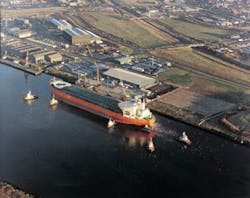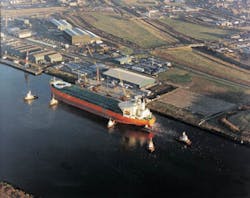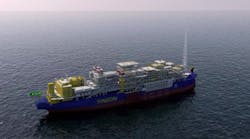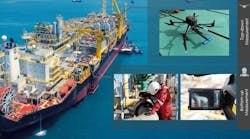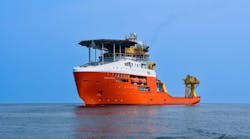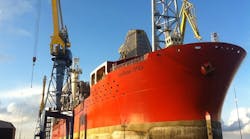Some solutions for cost, schedule management
Stephen SwindellGenesis Oil & Gas Consultants
Richard Snell
BP Exploration
The newbuild FPSO Triton recently arrived at England's River Tees for outfitting by Kvaerner Oil & Gas. Once completed, it is due to be towed out this summer to its location in the Central North Sea, producing oil and gas from the Bittern, Guillemot West and Guillemot North West fields.A number of recent FPSOs, particularly on Europe's North West Continental Shelf, have taken longer to deliver than planned. As a result, they have also ended up costing more. This has been a frustration to the industry, since one of the benefits of the FPSO concept was supposed to be a cheaper and shorter schedule. Why have we lost this perceived advantage?
In part, issues surrounding the integration of topside oil production and marine systems have been blamed, although back-up for this belief is not always evident. Therefore, as part of a much wider investigation into FPSOs, BP commissioned a study last summer by Genesis Oil & Gas Consultants to look specifically at these systems and how their integration affects FPSO and design construction.
A review document was subsequently prepared, based partly on interviews with operators of seven FPSOs, two contractors, and one shipyard. This examined what the industry had done to date, and to highlight the problems and successes with the various approaches. It does not provide definitive solutions on how to integrate certain systems, but rather presents data and guidance from which project engineers and managers can hopefully benefit in future.
18 systems considered
Eighteen systems were considered from both a design and construction point of view - some of the findings are presented below.- Power generation/electrical distribution: A key problem of integrating power generation and electrical equipment is developing electrical load requirements early enough to suit shipyard schedules and opportunities. In cases where equipment is located in the engine room or other machinery spaces, the process of engineering definition and subsequent long lead time of certain items have caused problems with the hull schedule. One solution could be to site electrical switchgear on the main deck, which would allow it to be de-coupled from the hull construction schedule. Switchgear design is linked heavily to the process system design and as such is linked more logically to the topsides schedule. The same applies to power generation equipment.
If main deck space is at a premium, it may still be prudent to site switchgear in the hull - but if this decision is taken, the switchgear design must be managed to prevent a schedule clash (significant FEED work must have been executed prior to award of the shipyard contract).
- Control systems: A marine control system normally includes control for propulsion, position keeping, ballast control and offloading. Production plant control normally comprises production process control, fire and gas and emergency shutdown and subsea system controls. Integration of marine and topsides control is possible - however, the level of integration depends on propulsion philosophy and availability of technology. While a combined control system may suit an FPSO with no propulsion, or newbuild FPSOs, it also introduces extra interfaces, both physical and contractual, and can necessitate a large number of cables routed to a single point - creating a potential bottleneck during construction.
Separate control systems may be more suited to converted vessels with propulsion, and also make vendor selection easier. Overall, a single system comes out more favorably, but the interfaces it introduces need to be identified early and managed in accordance with the level of risk that it poses to schedule and cost.
- Seawater: Seawater pumps are employed to lift water from sea chests for distribution to seawater and deck water systems, the main user being the ballast water system. A typical offshore production system uses caisson-based pumps to supply cooling water to the process plant and for water injection. A number of FPSOs are benefiting from the decision to have separate topside seawater pumps in caissons set into or through ballast tanks. Firewater pumps are also on deck and in their own caissons. This approach was found to be cheap, effective and reliable. Caisson-style lift pumps are tried and tested offshore, and are easy to specify and install. Use of caissons in the hull allows pumps to be located near the process cooling or water injection plant end-users. This, in turn, reduces pipe runs and takes out a machinery space interface. Furthermore, pumps can then be specified much later in the design process. In addition, these pumps have a smaller footprint than traditional pumps, and also a lower operating cost.
- Vents: On tankers, inert gas vents are sized normally for the maximum inert gas rate, which is, in turn, sized based on the maximum offloading rate. On FPSOs, however, offloading rates are defined by oil production rates, which are roughly one tenth of the offloading rate. As a result, vents are normally over-sized, leading to poor mixing and dispersion. This causes problems with maintaining certain hazardous area classifications on deck, and has even created unsafe gas clouds. The lesson is that two separate vents should be provided - one for offloading and one for loading - or alternatively, a single vent sized for loading conditions with a bypass for offloading.
- Diesel: Diesel systems are easy to integrate on FPSOs, but the diesel treatment package must be specified for the most arduous duty, i.e. gas turbine fuel supply spec for solids and salts. Normal ship diesel treatment systems do not necessarily meet this requirement.
- Hazardous areas: Some conversions and even some newbuilds have experienced problems with hazardous area classification. A common misapplication is to use the marine tanker code and consider locations above 2.4 meters over the storage tank deck as non-hazardous. A significant lesson learned from the review was to not accept any concept of "safe areas" out on deck. All these areas should be treated as at least zone 2. This will ultimately simplify equipment specs and allow much more flexibility in regard to changes during the construction phase.
- Structural: Two noteworthy lessons were identified. Firstly, ships' cranes are not suited to offshore duty, since they are designed for calm jetty use, are slow and not dynamically rated - project teams should therefore insure that offshore specs are used for cranes. Second, design for blast and fire-proofing can be a problem for shipyards, which do not normally analyse over-pressure and fire exposures of topside equipment. The answer may be to transfer this design aspect to the topside contractor, or to assign help to the shipyard.
In certain FPSO projects, the review found, there is potential to combine the cargo tank blanketing system with the topsides production plant in order to recover VOCs, and also to integrate this with a flare recovery system (provided that there is a disposal route for gas, via export or reinjection).
Integration perspective
None of the systems covered in the review were identified per se as prime causes reasons of cost and schedule over-runs. They were simply second order problems behind issues such as shipyard tender process and degree of front-end loading, contractual strategies and construction planning. There are no rights and wrong ways to integrate topside and marine systems on FPSOs - the key lies in planning and management. Understanding some of the specific issues, however, will aid that process.Gains can be made from simplifying systems integration for newbuild FPSOs provided that sufficient engineering has been undertaken prior to placing shipyard orders. Problems have arisen from the shipyard not comprehending (or having been fully informed) of their requirements. If a project is heavily front-end loaded - allowing for significant definition prior to placement of hull orders, every effort should be made to integrate systems where possible. If, however, the schedule prevents significant FEED work, little or no integration should be attempted.
The review revealed significant support for outright avoidance of integration, to assure fulfilment of cost and schedule performance. This means that the topside production plant, including utilities, should be designed and built entirely by the topsides design contractor.
On existing ships, consider mothballing all marine equipment in the hull/engine room, and provide all production and support utility equipment on the deck. With newbuilds, avoid putting anything in the engine room, to minimize interfaces between the hull and the production systems and also to prevent access restrictions.
Early on in a project, the degree of integration is not likely to be viewed as a major cost driver. But historically, integration has proven to be a risk to cost and schedule overruns. To lessen this risk, integration of topside and marine systems should either be minimized or alternatively maximized during the design phase, identified as a potential threat to schedule and cost during the construction phase, and then managed accordingly.
Reference:
13th Annual Floating Production Systems Conference, organized in London by IBC UK Conferences, December 1998.Copyright 1999 Oil & Gas Journal. All Rights Reserved.
